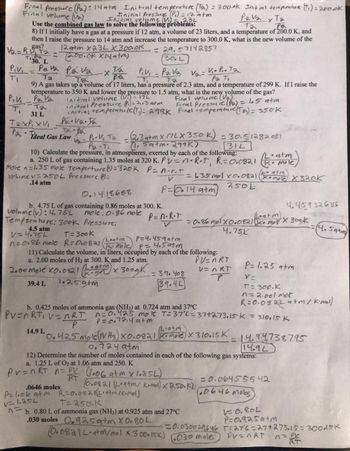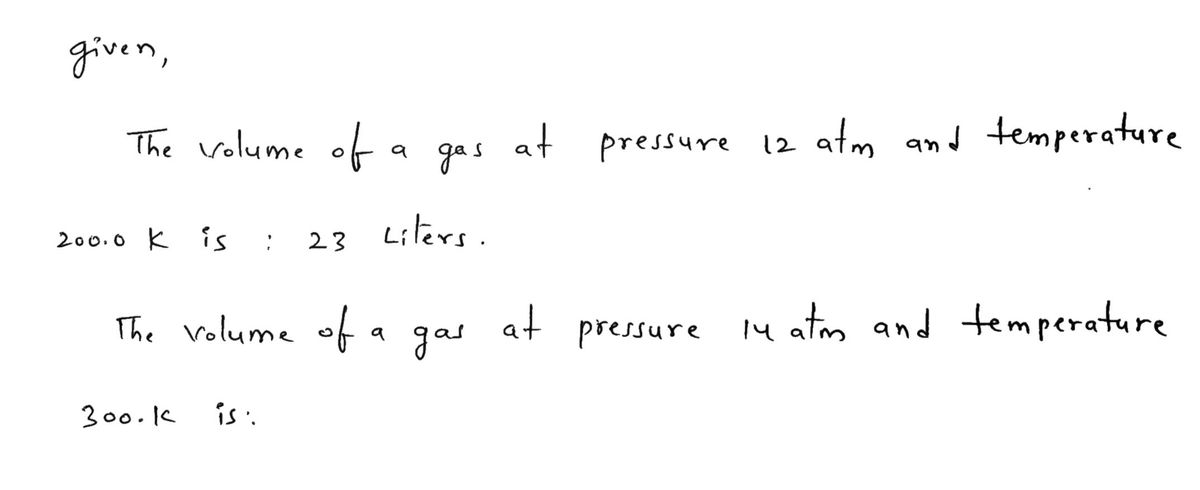
Chemistry
10th Edition
ISBN: 9781305957404
Author: Steven S. Zumdahl, Susan A. Zumdahl, Donald J. DeCoste
Publisher: Cengage Learning
expand_more
expand_more
format_list_bulleted
Concept explainers
Question
thumb_up100%
Can you help me with number 8? Was this the correct answer that shows my work includes the significant figures? Also, can you help me with the combined

Transcribed Image Text:Final Pressure (P₂): 14 atm Initial temperature (Ta) = 300.ok Initial temperature (1₁) = 200.ok
Final volume (V₂)
(P) = 12 atm
Pavax Ta
та
Pa
8) If I initially have a gas at a pressure if 12 atm, a volume of 23 liters, and a temperature of 200.0 K, and
then I raise the pressure to 14 atm and increase the temperature to 300.0 K, what is the new volume of the
V₂ = P gas?
T2
12 atm x23L X300.0K
(200.0k X14atm)
= 29.57142857
30. L
pressure.
Initial volums
Use the combined gas law to solve the following problems:
Ti.Pa
30. L
Piv, Pava Pav₂ x ta
Ta
V2=
V₁. P₁. Ta
Pa Ti
TI
Ta
T₁
9) A gas takes up a volume of 17 liters, has a pressure of 2.3 atm, and a temperature of 299 K. If I raise the
temperature to 350 K and lower the pressure to 1.5 atm, what is the new yolume of the gas?
PIVI Pa Va
Final volume (V₂)
initial volume (V.) = 172
initial Pressure (P₁) = 2.3 atm
T₂
31 L
Final Pressure (P₂) = 1.5 atm
initial temperature (T) = 299k Final temperature (To) = 350k
TaxPixVi
Pa.va.ta
=
=
Pa deal Gas Law
TX.B₂
12=
-XT2 P₁V₁ - P₂V₂
Ta
P.V₁ Ta
=
2.3atm x 77LX 350 k)
11. Sa+m. 299K)
= 30.51282051
31L
Pa Ti
10) Calculate the pressure, in atmospheres, exerted by each of the following:
a. 250 L of gas containing 1.35 moles at 320 K. Pv=n·R·T, R=0.0821
Mole n=1.35 mote Temperture (1)=320K P = n.r.r
Volume v= 250L Pressure =
V
.14 atm
P=014 atm
0.1418688
b., 4.75 L of gas containing 0.86 moles at 300. K.
mole: 0.86 mole
Pressure:
14.9 L
volume (v): 4.75L
Temperature: 300k
4.5 atm
V=4.75L
T= 300k
/Leatm
p=4.459atm
n=0.86 mole R=0.0821 (K+mole)
P = 4.5atm
11) Calculate the volume, in liters, occupied by each of the following:
a. 2.00 moles of H₂ at 300. K and 1.25 atm.
PV=nRT
V=nRT
2.00 mole X0.0821 (2) × 300.0K
1.259tm
39.4 L
P=n·R·T
V
= 39. 408
39.4L
= 1.35 mol x 0.0821 Komole X 320K
250L
= 0.86 molx0.0821 (atm).
4.75X
(2·atm
0.425 mole (NH3) X0.0821 (Komple) X 310.15K_
b. 0.80 L of ammonia gas (NH3) at 0.925 atm and 27°C
.030 moles 0.925 atm X 0.80 L
• atm
mole
b. 0.425 moles of ammonia gas (NH3) at 0.724 atm and 37°C
PV=nRT₁ V = nRT n=0.425 mol T=37°C = 37+273.15-k = 310.15 K
atm
P
= 14.94738795
14.92
0.7249tm
12) Determine the number of moles contained in each of the following gas systems:
a. 1.25 L of O2 at 1.06 atm and 250. K
Pr=nRT = P (1.06 atm x 1.25L)
RT
0.0821 (Leatm/ kmal) X 250.K)
P=1.06 atm R=0.0821 (L.atm/K+mol)
.0646 moles
v1.25L
T=250.K
^=
Komor X 300k
=0.030029646
0.0821L.atm/mol x 300.15K) (030 mole
4.459326316
P= 1.25 atm
V=
T = 300.K
n = 2.001 mot
R=0.082L a+m/ Kime)
= 0.06455542
(.0646 Moles)
PV=nRT
V=0.80L
P=0.925atm
T=276=27+273.15= 30045K
(4.5atm)
= RY
n = PV
Expert Solution
arrow_forward
Step 1

Step by stepSolved in 3 steps with 3 images

Knowledge Booster
Learn more about
Need a deep-dive on the concept behind this application? Look no further. Learn more about this topic, chemistry and related others by exploring similar questions and additional content below.Similar questions
- If 16.6 mol of Ne gas occupies 73.5 L, how many mol of Ne would occupy 790.7 L under the same temperature and pressure? Record your answer in scientific notation using 3 significant figuresarrow_forward7. ( A student performs the Avogadro's portion of the experiment and obtains the following graph. Using this information, if the syringe has a volume of 50.0 mL, how much NaHCO3 (in grams) should the student add to completely fill the syringe with CO₂ gas? I Volume (mL) Avogadro's Law Plot 30.0 22.5 R¹ 0.9914 15.0 7.5 0.0 y= 26417x-4.3768 0.0E+00 3.0E-04 6.0E-04 9.0E-04 1.2E-03 moles of CO2 Lawarrow_forwardA gas has a volume of 3.49 L at 0°C. What final temperature, in degrees Celsius, is needed to change the volume of the gas to each of the following, if n and P do not change? Part A You may want to reference (Pages 268 - 269) Section 8.3 while completing this problem. 1.63 L Express your answer to three significant figures in degrees Celsius. ΑΣΦ 国? °C %3D Submit Request Answer Part B 1300 mL Express your answer to three significant figures in degrees Celsius. ΑΣφ ? T = %3D °C Submit Request Answerarrow_forward
- 27. Mass Volume Circle all of the following that are the SAME for the two samples of gas represented above: Number of gas particles Total number of atoms Temperature Pressure Carbon Monoxide (CO) 8 moles 25 °C 5.0 L Density Molecular Speed (avg) Kinetic Energy (avg) Danger Argon (Ar) 8 moles 25 °C 5.0 L (Please type answer no write by hend)arrow_forwardA sample of gas was determined to have a mass of 20.41g and a density of 0.810g/mL. What is the volume (in units of milliliters, mL) of the gas?arrow_forwardDescription You will use an online simulation to manipulate and calculate the four properties of gases: Pressure, Volume, Quantity, and Temperature. You will also apply your knowledge to several scenarios. To begin, open the simulation, Gases Intro, from https://phet.colorado.edu/sims/html/gases-intro/latest/gases-intro en.html. This will open it in another window. Select the simulation box Intro at the bottom. When it opens, check Width to show the width of the box. You should leave the rest unchecked. We will only use Heavy Particles. Play around with the simulation to see how to adjust the volume/width (handle on left of box), temperature (bucket below with either ice or fire), and quantity (using the pump handle to right of the box). Keep the box sealed by keeping top door closed. When you are ready to do the experiments, reset the simulation by pressing the white eraser button on bottom right, make sure width is 10.0 nm, and set to heavy particles (purple gas molecules).…arrow_forward
- Gases You should be able to answer this prompt using 10 sentences or less. Gases are very important for life in terms of respiration and photosynthesis. However, gases play other critical roles in our daily lives. Think about the past month. Did you use any product that is a gas at room temperature? What was the product or substance? State one chemical or physical property of the substance that is unique because it is a gas.arrow_forwardtakt Values if needed for this question. What is the total volume of gaseous products formed when 84.0 liters of bromine trifluoride react completely according to the following reaction? (All gases are at the same temperature and pressure.) bromine trifluoride(g) → bromine (g) + fluorine(g) Volume= Larrow_forwardSelect the most appropriate term for each relationship. You may use each choice once, more than once, or not at all. Volume is/has moles. Moles is/has temperature. Pressure is/has temperature. 1. proportional to 2. inversely proportional to Pressure is/has moles. 3. has no relationship to Pressure is/has volume. Volume is/has temperature. > 1001 Aarrow_forward
- Could you please explain what formula's/equations are needed to come up with the correct answer to the problem?arrow_forwardab Y Part A Calculate the density of krypton gas at a pressure of 747 mmHg and a temperature of 44 °C. Express the density to three significant figures and include the appropriate units. esc p= Value Submit Provide Feedback μА Request Answer Mother to Son &....pdf ! 1 F1 Q @ 2 C Units F2 W #3 ? 80 F3 E S4 $ a F4 R % 5 0 KO F5 MacBook Air T F6 6 & 7 Yarrow_forwardIf Cl₂ gas contains 3.25x10²6 atoms, how many liters are present @STP? Use only the following units • atoms or particles or molecules .L • molarrow_forward
arrow_back_ios
SEE MORE QUESTIONS
arrow_forward_ios
Recommended textbooks for you
 ChemistryChemistryISBN:9781305957404Author:Steven S. Zumdahl, Susan A. Zumdahl, Donald J. DeCostePublisher:Cengage Learning
ChemistryChemistryISBN:9781305957404Author:Steven S. Zumdahl, Susan A. Zumdahl, Donald J. DeCostePublisher:Cengage Learning ChemistryChemistryISBN:9781259911156Author:Raymond Chang Dr., Jason Overby ProfessorPublisher:McGraw-Hill Education
ChemistryChemistryISBN:9781259911156Author:Raymond Chang Dr., Jason Overby ProfessorPublisher:McGraw-Hill Education Principles of Instrumental AnalysisChemistryISBN:9781305577213Author:Douglas A. Skoog, F. James Holler, Stanley R. CrouchPublisher:Cengage Learning
Principles of Instrumental AnalysisChemistryISBN:9781305577213Author:Douglas A. Skoog, F. James Holler, Stanley R. CrouchPublisher:Cengage Learning Organic ChemistryChemistryISBN:9780078021558Author:Janice Gorzynski Smith Dr.Publisher:McGraw-Hill Education
Organic ChemistryChemistryISBN:9780078021558Author:Janice Gorzynski Smith Dr.Publisher:McGraw-Hill Education Chemistry: Principles and ReactionsChemistryISBN:9781305079373Author:William L. Masterton, Cecile N. HurleyPublisher:Cengage Learning
Chemistry: Principles and ReactionsChemistryISBN:9781305079373Author:William L. Masterton, Cecile N. HurleyPublisher:Cengage Learning Elementary Principles of Chemical Processes, Bind...ChemistryISBN:9781118431221Author:Richard M. Felder, Ronald W. Rousseau, Lisa G. BullardPublisher:WILEY
Elementary Principles of Chemical Processes, Bind...ChemistryISBN:9781118431221Author:Richard M. Felder, Ronald W. Rousseau, Lisa G. BullardPublisher:WILEY

Chemistry
Chemistry
ISBN:9781305957404
Author:Steven S. Zumdahl, Susan A. Zumdahl, Donald J. DeCoste
Publisher:Cengage Learning

Chemistry
Chemistry
ISBN:9781259911156
Author:Raymond Chang Dr., Jason Overby Professor
Publisher:McGraw-Hill Education

Principles of Instrumental Analysis
Chemistry
ISBN:9781305577213
Author:Douglas A. Skoog, F. James Holler, Stanley R. Crouch
Publisher:Cengage Learning

Organic Chemistry
Chemistry
ISBN:9780078021558
Author:Janice Gorzynski Smith Dr.
Publisher:McGraw-Hill Education

Chemistry: Principles and Reactions
Chemistry
ISBN:9781305079373
Author:William L. Masterton, Cecile N. Hurley
Publisher:Cengage Learning

Elementary Principles of Chemical Processes, Bind...
Chemistry
ISBN:9781118431221
Author:Richard M. Felder, Ronald W. Rousseau, Lisa G. Bullard
Publisher:WILEY